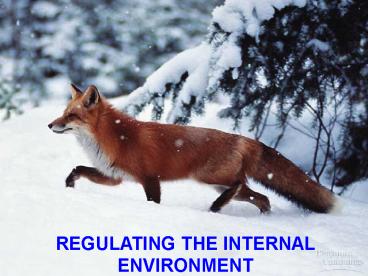REGULATING THE INTERNAL ENVIRONMENT - PowerPoint PPT Presentation
1 / 26
Title:
REGULATING THE INTERNAL ENVIRONMENT
Description:
Title: Slide 1 Author: Fred Steinkamp Last modified by: Annette.JonesPolk Created Date: 4/29/2003 3:05:21 PM Document presentation format: On-screen Show (4:3) – PowerPoint PPT presentation
Number of Views:54
Avg rating:3.0/5.0
Title: REGULATING THE INTERNAL ENVIRONMENT
1
REGULATING THE INTERNAL ENVIRONMENT
2
Thermoregulation Q10 effect- there is a 2-3 times
increase for metabolic reactions for each 10C
rise in temperature. Conduction-direct
transfer Convection-movement of air or water past
a surface Radiation-between objects not in
contact through electromagnetic waves
Evaporation-removal of heat from the surface of a
liquid by losing molecules as a gas Can
all of these be a source of gain or loss?
3
Ectotherm-low metabolic rate does not generate
enough heat to effect body temperature.
Endotherm-High metabolic rate generates heat to
maintain body temperatures higher than the
environment
4
Thermoregulation
- Adjusting the rate of heat exchange between the
animals and surrounding. Vasodilation---
vasoconstriction--- Countercurrent heat
exchangers - Cooling by evaporative loss. Panting and
perspiration- only way to lose heat if
environment is warmer than the body temperature - Behavioral responses. Positioning hibernation
migration - Changing the rate of metabolic heat production.
Shivering Nonshivering thermogenesis-hormones
cause mitochondria to increase their metabolic
rate special tissue called brown fat
5
(No Transcript)
6
(No Transcript)
7
acclimatization- stress-induced proteins which
include heat-shock proteins torpor-general term
for a physiological state in which activity is
low and metabolism decreases hibernation- estiva
tion- daily torpor-
8
Beldings ground squirrel hibernates to conserve
energy
9
Osmoregulation
can drink seawater
Involves some type of transport epithelium that
have selectively permeable membranes for the
transport of specific solutes. Many tight
junctions between cells. Use large amounts of
ATP for active transport. Purpose is to maintain
the composition of the cytoplasm of the bodys
cells. Accomplished indirectly by maintaining
the interstitial fluid and blood
10
Less toxic-Higher conc. less water
Most toxic-Low concentrations more water released
Least toxic-Highest conc. least water
11
osmoconformer-does not actively adjust its
internal osmolarity because it lives in an
isoosmotic environment osmoregulator-must
control its internal osmolarity because it
internal fluids are not isoosmotic with its
environment stenohaline-cannot tolerate
substantial changes in external osmolarity and
thus are usually osmoregulators euryhaline-can
tolerate substantial changes in external
osmolarity
12
(No Transcript)
13
(No Transcript)
14
Anhydrobiosis- tardigrades (water bears) inhabit
temporary ponds can go from 85-2 water and
survive for ten years
15
(No Transcript)
16
Key functions of Excretory Systems
17
Protonephridia of planarian flame-bulb
system-fluid is filtered into the bulb produces
very dilute urine but there is some reabsorption
of solutes by the tubules.
18
Metanephridia-take in coelomic fluid (filtration)
and then reabsorb the nutrients produces a
dilute urine that allows them to get rid of
excess water absorbed from damp soil
19
Malpighian tubules of the insects nitrogenous
wastes are secreted into the lumen of the tubes
from the hemolymph and then it passes into the
rectum nitrogenous wastes are converted to
insoluble nitrogenous wastes and are released
with the solid waste
20
(No Transcript)
21
vasa recta
22
Adjustments on NaCl, K and pH
Filtration
Reabsorption Secretion
permeable to water but impermeable to NaCl
interstitial fluid is more hyperosmotic
Active transport
permeability to water is affected by ADH
Passive transport
impermeable to water permeable to NaCl
23
(No Transcript)
24
(No Transcript)
25
(No Transcript)
26
ADH-increases the permeability of the collecting
ducts to water Juxtaglomerular apparatus near
the afferent arteriole secrete renin when the BP
drops renin converts angiotensinogen to
angiotensin II that increases BP in several
ways Aldosterone-causes distal tubules to
reabsorb more NaCl and water thus increasing
blood volume and pressure Atrial natriuretic
factor lowers BP by opposing renin and aldosterone































